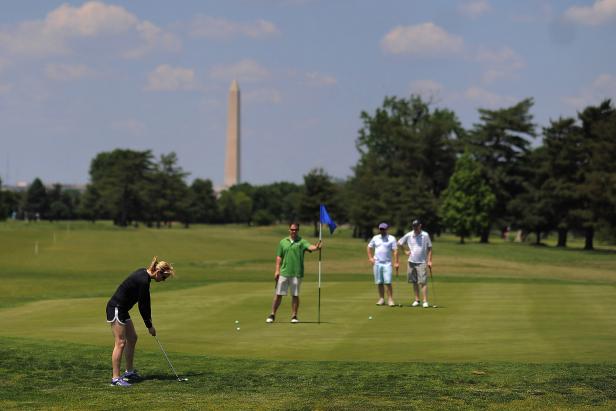There’s an old saying, particularly appropriate in these times, that proclaims “be the change you want to see.” Mike McCartin and Will Smith, golf course shapers and designers turned public golf advocates, have done exactly that by taking the fate of three of their hometown’s historic old courses into their own hands—with some significant help from friends.
McCartin and Smith formed National Links Trust last year, a non-profit organization originally created to help preserve, promote and restore affordable, architecturally significant municipal golf courses throughout the U.S. Specifically, they created the foundation as a vehicle to promote the rehabilitation of the East Potomac Park, Rock Creek and Langston golf courses, beloved but physically compromised Washington, D.C., golf locations.
Their work in drawing attention to the important nature of public golf and the way these particular courses provide social and recreational value to their neighborhoods paid off this week when the National Park Service, which owns the courses, announced it has entered into an operational contract with National Links Trust. The two entities—in partnership with Troon, one of game’s largest golf management companies—are currently negotiating terms for an extended lease.
The long-term masterplan includes the renovation or rebuilding of each course as well as capital projects to help improve infrastructure, aesthetics, on-site structures and the strengthening of community bonds. It’s one of the most ambitious and comprehensive public golf projects in years, one designed to honor the tradition and history of each course, and it’s drawn important support from golf architects Tom Doak, Beau Welling, Gil Hanse and Jim Wagner, each of whom have agreed to renovate one of the golf courses. Developer Mike Kaiser is serving as a project advisor.
“One of the things I was most impressed by with the park service was their emphasis on the histories of the courses,” McCartin told Golf Digest. “Taking a preservation angle, they documented both the golf architectural histories as well as the social histories in incredible detail.”
From a pure golf perspective, the most comprehensive restoration will involve the Walter Travis-designed Blue Course at East Potomac Park, where McCartin first learned the game at the age of eight, hitting golf balls on the range with this father and brother. The 36-hole complex is located on a man-made island in the Potomac River south of the National Mall. Views out to the river will be expanded and drainage issues will be addressed. Then Doak will orchestrate a restoration that will bring back the vivacity of Travis’ architecture, notably his numerous and distinctive bunkering patterns that had almost entirely been bulldozed out of existence through time.
Hanse and Wagner will be tasked with reconstructing and reconfiguring Rock Creek, to the north of the city. The course lost several holes when a highway was built through its south flank in the late 1950s, forcing chain-reaction changes throughout the layout. The plan now is to reconfigure the holes in ways that reflect what was once there while reviving the design sensibilities of William Flynn, who completed the course in 1926. A new, nine-hole short course is also in the plans.
Langston, which Welling will oversee, needs the least amount of intensive golf course work, though its setting along the Anacostia River will be accentuated by opening up water views.
“At Langston, the majority of our investment will be with the community-oriented part of the operation,” McCartin says. “Langston has traditionally been really successful at providing programs for the surrounding communities, many of them communities of color.”
Langston was one of the first golf courses in the country that African-Americans could play, and it has a long history of providing access to the game and functioning as a kind community gathering place.
Where this ambitious project can have an impact nationally is by setting an example in its commitment to honoring the roots of each of these courses and the inclusive, local spirit of golf and recreation that they’ve always embodied. Too often, proposals to improve municipal or public-access urban courses have suffered with misguided redevelopment aspirations, often with goals of widespread socio-economic change, hosting a PGA Tour event or cultivating $200 non-resident green fees. Sometimes, golf course just need TLC and rejuvenation, not fundamental change.
“Our focus is on maintaining the cultures that have existed here for years because of their locations and affordability,” McCartin says. “National parks are really for everybody. In this case, the golf will be mostly for local players, but you don’t want to price discriminate against people coming from somewhere else. So our approach is, affordable for everybody. The culture should be inclusive.”
McCartin estimates the entire scope of the undertaking will take a decade to come to fruition and obtaining the management contract is only the first of many hurdles. But this far into the story, the feeling remains hopeful.
“It causes you to look back and appreciate, from a personal perspective, how much history I have with these courses and the chance to be involved with them into the future, and from a group with how much work we put in getting to this point,” he says. “To have this opportunity is incredibly exciting and really special. But now it’s time to refocus and find a way to make all of this stuff happen.”
Change happens locally, is another old saying. It also happens one—or three—golf courses at a time.
